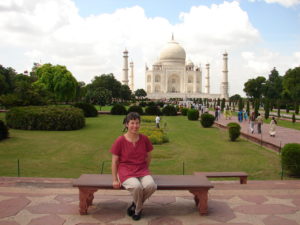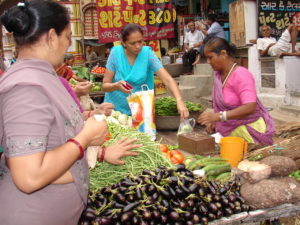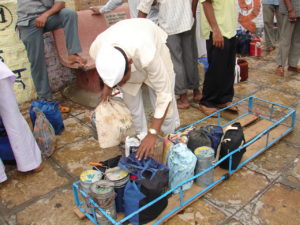Scott Hemker’s recent posts about Spanish tapas not only gave me an appetite, they also inspired me to write a post about food. One of my favorite places to travel (and eat) is India. I spent six weeks in India on a Fulbright-Hays Seminars Abroad fellowship in 2006 with a small group of teachers. Just days after the July 11, 2006, train bombings in Mumbai (Bombay) which took the lives of over 200 people and injured over 700, our group arrived in that city, the financial capital of India. Mumbai is also where “Bollywood,” the Hindi-language film industry, is based. Our movements were not restricted, but the security was tight and the police presence was heavy. I felt quite safe and Mumbai ended up being one of my favorite places to visit. Very little on our official agenda was cancelled. One of our scheduled activities was a chance to observe a lunch-delivery service that dates back to the late 19th century when India was still under British rule.
The lunches that are delivered each day are cooked at home by wives, mothers, and grandmothers who live in the suburbs for their husbands, sons, and grandsons who work in the city. For those men without such devoted family members, they can get their lunches from companies that specialize in “home cooking.” The more than 5,000 men and a few women who deliver these lunches to thousands of customers each day are called dabbawalas (also spelled as dabbawallas or dabbawallahs) and their work has caught the attention of documentary film makers, Forbes magazine, international management schools, and even Prince Charles. Early in the morning, they collect the home-cooked food that is packed in stacked metal lunch boxes called tiffins and through a complex, but accurate delivery system that involves bicycles, trains, and wooden carts, they deliver these lunches to the men at work. Some of Mumbai’s dabbawalas carry their loads on their heads and walk quickly to their destinations.
Prince Charles is not the only fan of Mumbai’s dabbawalas. Forbes magazine gave them a Six Sigma rating based on the delivery service’s reliability, efficiency, and punctuality. That means for every six million lunches delivered, less than one lunch will end up missing. Harvard University conducted a case study of the dabbawalas that is a part of its MBA curriculum. Mumbai’s dabbawalas are certainly an inspiring group. My Fulbright group was able to watch them as they delivered their loads of tiffins to the office workers.
The population of Mumbai is nearly 14 million and the dabbawalas manage to deliver their lunches to hungry downtown office workers in all kinds of weather, including monsoons. The dabbawalas are efficient, organized, and precise, but certainly not high tech. They depend on a color coding system of numbers and letters that are painted on the tiffins that tell them where the lunches are to be delivered in the maze of office buildings in Mumbai. The lunches are picked up at the customers’ homes in the morning and then taken to local railway stations where they are sorted. Once the tiffins arrive in central Mumbai, they are sorted again and carried to their final destinations. In the afternoon after the lunches are eaten, the delivery system is reversed so that the tiffins are returned to the homes to be washed by the female family members and packed again the next morning.
On a state visit to India in 2003, Prince Charles met with a few of Mumbai’s dabbawalas and was quite impressed by their unique business model. Two of the dabbawalas were guests at his 2005 wedding to Camilla Parker Bowles, now the Duchess of Cornwall. Interestingly, not a single famous individual from India was invited to this royal wedding. Our Fulbright group was based in the same hotel in New Delhi where Prince Charles stayed with his first wife, Princess Diana in 1992. I read in one of the numerous books published about their disintegrating marriage that they had separate suites on different floors in that hotel. Princess Diana was photographed alone in front of the Taj Mahal during that visit. Sadly, the royal couple separated later that year.
I packed my final lunch for the 2011-2012 school year last Friday. I may replace my old LL Bean lunch bag with a stainless steel tiffin, just like the ones delivered by Mumbai’s dabbawalas. Unfortunately, I will not be able to fill the different tiers with all that delicious Indian food. Now that would be a service I would gladly pay for!
Readers, have you traveled to India? What have been your own interesting travel experiences with food?
(Editor’s note: Add Gail on Google+ If you have a question about for EF Group Leader Gail Ingram, or an idea for a blog post topic, you can email Gail here, and she will answer readers’ questions in future blog posts.)
Related articles



